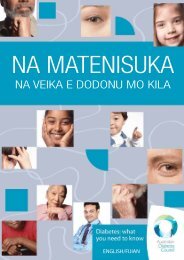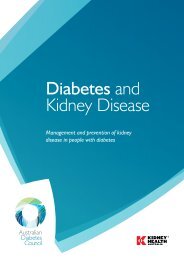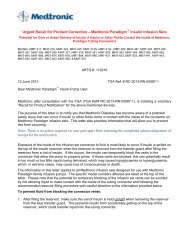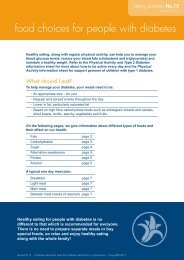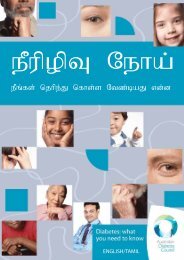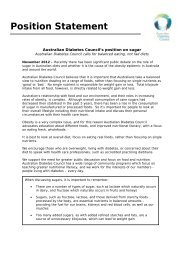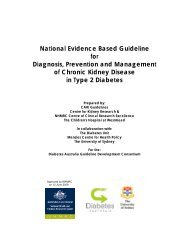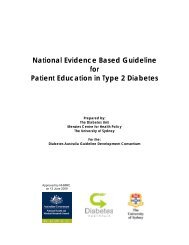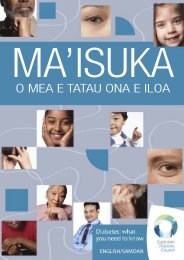The other frequently reported method is the biothesiometer. This is a h<strong>and</strong>held devicewhich vibrates at 100Hz <strong>and</strong> connects by an electrical cord to a base unit whichallows the voltage to be <strong>in</strong>creased by the operator through a range <strong>of</strong> 0 to 50V whichis displayed on a scale. This <strong>in</strong>strument is popular <strong>in</strong> specialist diabetes units but is<strong>in</strong>frequently used <strong>in</strong> the primary care sett<strong>in</strong>g.<strong>Foot</strong> exam<strong>in</strong>ation <strong>of</strong> people with diabetes is <strong>of</strong>ten <strong>in</strong>adequate. One study <strong>of</strong> peopleadmitted to a teach<strong>in</strong>g hospital with diabetes foot problems reported that less than15% received a m<strong>in</strong>imally competent lower limb exam<strong>in</strong>ation as part <strong>of</strong> their rout<strong>in</strong>ecare (Armstrong et al, 1998).Evidence – <strong>Detection</strong> <strong>of</strong> Loss <strong>of</strong> Protective <strong>Foot</strong> SensationLoss <strong>of</strong> sensation to the 10g Semmes-We<strong>in</strong>ste<strong>in</strong> mon<strong>of</strong>ilament predicts footulceration <strong>and</strong> amputationIn a systematic review, Mayfield <strong>and</strong> Sugarman (2000) identified 6 prospectivestudies us<strong>in</strong>g the 10g Semmes-We<strong>in</strong>ste<strong>in</strong> mon<strong>of</strong>ilament <strong>and</strong> 4 us<strong>in</strong>g VPT to predictthe risk <strong>of</strong> foot ulceration <strong>and</strong> amputation. Among people who were unable to feel theSemmes-We<strong>in</strong>ste<strong>in</strong> mon<strong>of</strong>ilament which was tested <strong>in</strong> 1 to 4 sites <strong>in</strong>clud<strong>in</strong>g theplantar surface <strong>of</strong> the toes, metatarsal heads, <strong>in</strong>sole, <strong>and</strong> heel, <strong>and</strong> the dorsum <strong>of</strong> thefoot, the odds ratio (OR) <strong>of</strong> <strong>in</strong>creased risk <strong>of</strong> ulceration ranged from 4.1 (CI 1.89-8.87) to 18.4 (CI 3.83-88.47), <strong>and</strong> the relative risk (RR) <strong>of</strong> amputation ranged from2.2 (CI 1.5-3.1) to 9.9 (CI 4.8-21.0). Similarly, the risk <strong>of</strong> ulceration <strong>in</strong>creased <strong>in</strong>people with VPT >25, with an OR rang<strong>in</strong>g from 4.4 (CI 1.1-17.3) to 10.8 (CI 4.6-25.7).The follow<strong>in</strong>g provides more details on studies <strong>in</strong>cluded <strong>in</strong> the above systematicreview. In prospective studies, the 10g Semmes-We<strong>in</strong>ste<strong>in</strong> mon<strong>of</strong>ilament has emergedas the most sensitive test for peripheral neuropathy <strong>in</strong> predict<strong>in</strong>g foot ulcer risk.Boyko <strong>and</strong> coworkers (1999) studied 749 US veterans with diabetes who werefollowed up for a mean <strong>of</strong> 3.7 years. 163 ulcers developed dur<strong>in</strong>g the follow-up. Therisk <strong>of</strong> develop<strong>in</strong>g a foot ulcer was significantly higher for <strong>in</strong>ability to perceive the10g Semmes-We<strong>in</strong>ste<strong>in</strong> mon<strong>of</strong>ilament at one or more <strong>of</strong> 9 sites (RR 3.37, CI 2.45-4.63; p
tendon reflexes (OR 6.48, CI 2.37–18.06), while absent vibration sensation was not asignificant <strong>in</strong>dependent risk factor (McNeely et al, 1995).In another prospective study <strong>of</strong> native American Indians, sensory status wasdeterm<strong>in</strong>ed by the 10g Semmes-We<strong>in</strong>ste<strong>in</strong> mon<strong>of</strong>ilament applied to 8 po<strong>in</strong>ts on theplantar surface <strong>of</strong> each foot. The 358 subjects were bl<strong>in</strong>dfolded <strong>and</strong> retested twicebefore be<strong>in</strong>g classified as <strong>in</strong>sensate (if they consistently failed to feel the filament atone or more locations). 68 subjects were unable to feel the mon<strong>of</strong>ilament at screen<strong>in</strong>g.Among this group, there was a significantly <strong>in</strong>creased risk <strong>of</strong> subsequent ulceration(OR 9.9, CI 4.8-21.0) <strong>and</strong> amputation (OR 17, CI 4.5-95.0) compared with those whoreta<strong>in</strong>ed sensation (Rith-Najarian et al, 1992).In another case-control, 30 people with recent or current foot ulceration werecompared with 85 controls without a history <strong>of</strong> foot ulcer (Armstrong et al, 1998).The sensitivity <strong>and</strong> specificity <strong>of</strong> VPT test<strong>in</strong>g assessed us<strong>in</strong>g a biothesiometer, the 10gSemmes-We<strong>in</strong>ste<strong>in</strong> mon<strong>of</strong>ilament <strong>and</strong> a 4-question verbal neuropathy score werecompared. Overall, VPT > 25V or four or more <strong>of</strong> eight imperceptible mon<strong>of</strong>ilamentsites had higher sensitivity (100%) <strong>and</strong> specificity (76.5%) than the symptom score.However comb<strong>in</strong><strong>in</strong>g the modalities <strong>in</strong>creased specificity (88.2%) but sensitivitydecreased to 88.2%. Armstrong <strong>and</strong> coworkers recommend the mon<strong>of</strong>ilament as an<strong>in</strong>expensive <strong>and</strong> reliable method for use <strong>in</strong> primary care, nurs<strong>in</strong>g or specialist practice.The different screen<strong>in</strong>g techniques to identify diabetic people at high risk <strong>of</strong> footulceration were compared by Pham <strong>and</strong> coworkers (2000) <strong>in</strong> 248 people who werefollowed up for 30 months. <strong>Foot</strong> ulcers developed <strong>in</strong> 73 people or 95 feet dur<strong>in</strong>g thestudy. People with foot ulcer were more likely to be <strong>in</strong>sensate to the 10g Semmes-We<strong>in</strong>ste<strong>in</strong> mon<strong>of</strong>ilament (p=0.000), had a higher neuropathy symptom score (NDS)(p=0.000), a high VPT (p=0.000), <strong>and</strong> high foot pressure (p=0.000) compared withpeople who did not develop a foot ulcer. Of these techniques, <strong>in</strong>ability to feel themon<strong>of</strong>ilament comb<strong>in</strong>ed with high NDS had a sensitivity <strong>of</strong> 99% for foot ulcerdevelopment, while the best specificity <strong>of</strong> 78% was seen with the comb<strong>in</strong>ation <strong>of</strong> highNDS <strong>and</strong> foot pressure. A multivariate analysis showed that significant factors fordevelop<strong>in</strong>g foot ulcer were high NDS (OR 3.1, CI 1.3-7.6, p=0.013), high VPT (OR3.4, CI 1.7-6.8, p=0.001), <strong>in</strong>ability to detect the mon<strong>of</strong>ilament (OR 2.4, CI 1.1-5.3,p=0.036), <strong>and</strong> high foot pressure (OR 2.0, CI 1.2-3.3, p=0.007). The authorsconcluded that cl<strong>in</strong>ical exam<strong>in</strong>ation comb<strong>in</strong>ed with test<strong>in</strong>g with the 10g Semmes-We<strong>in</strong>ste<strong>in</strong> mon<strong>of</strong>ilament is the most sensitive test <strong>in</strong> identify<strong>in</strong>g people at high risk forfoot ulceration.The 10g Semmes-We<strong>in</strong>ste<strong>in</strong> mon<strong>of</strong>ilament is cl<strong>in</strong>ically reliableIn 1,001 people attend<strong>in</strong>g a UK diabetes cl<strong>in</strong>ic, foot exam<strong>in</strong>ation was performed withthe 10g Semmes-We<strong>in</strong>ste<strong>in</strong> mon<strong>of</strong>ilament, biothesiometer <strong>and</strong> pulse palpation(Klenerman et al, 1996). 229 people with an <strong>in</strong>itial abnormal test were <strong>in</strong>vited for asecond test. Of this group, 21.8% had loss <strong>of</strong> protective sensation as judged by theabsence <strong>of</strong> some or all protective sensation to the mon<strong>of</strong>ilament; 7.7% had absentpedal pulses <strong>and</strong> 4% had comb<strong>in</strong>ed vascular <strong>and</strong> sensory loss. Between the twotest<strong>in</strong>gs the biothesiometer variation was considered cl<strong>in</strong>ically unacceptable. Theresults for palpation <strong>of</strong> pedal pulses were more stable, with 81% <strong>of</strong> people hav<strong>in</strong>g thesame results for the posterior tibial pulse on the right, compared to 70% on the left43
- Page 1: National Evidence Based Guidelinesf
- Page 4: Research OfficersMs Linda SmithPodi
- Page 7 and 8: 2.2 Issues for Foot Problems in Typ
- Page 9: • Aim to achieve the best possibl
- Page 12 and 13: Background - Peripheral Neuropathy
- Page 14 and 15: proportion of subjects with a durat
- Page 16 and 17: and an OR 1.1-7.8. This study also
- Page 18 and 19: Summary - Peripheral Neuropathy as
- Page 20 and 21: Section 2: Diabetes Foot ProblemsIs
- Page 22 and 23: predicting risk of amputation, 2.9
- Page 24 and 25: Summary - Peripheral Vascular Disea
- Page 26 and 27: Section 3: Diabetes Foot ProblemsIs
- Page 28 and 29: Evidence - Foot Deformity and Previ
- Page 30 and 31: people with both LJM and neuropathy
- Page 32 and 33: Summary - Foot Deformity and Previo
- Page 34 and 35: Section 4: Diabetes Foot ProblemsIs
- Page 36 and 37: Also in the Seattle study, 67 peopl
- Page 38 and 39: Summary - Ulcer as a Risk Factor fo
- Page 40 and 41: Section 5: Diabetes Foot ProblemsIs
- Page 44 and 45: side; and 82% having the same resul
- Page 46 and 47: Evidence Table: Section 5Detection
- Page 48 and 49: Background - Clinical Detection of
- Page 50 and 51: pulse was bilaterally absent in 1.8
- Page 52 and 53: Evidence Table: Section 6AuthorClin
- Page 54 and 55: Background - Frequency of Foot Exam
- Page 56 and 57: Summary - Frequency of Foot Examina
- Page 58 and 59: Section 8: Diabetes Foot ProblemsIs
- Page 60 and 61: Behaviour assessment scores, measur
- Page 62 and 63: Mazzuca et al (1986) studies 532 pe
- Page 64 and 65: with before the programme, after 1-
- Page 66 and 67: Evidence Table: Section 8AuthorEffe
- Page 68 and 69: Background - Glycaemic Control and
- Page 70 and 71: In a previous Japanese randomised s
- Page 72 and 73: Evidence Table: Section 9AuthorGlyc
- Page 74 and 75: Background - Footwear to Reduce Ulc
- Page 76 and 77: period. In addition people without
- Page 78 and 79: Comparisons of in-shoe foot pressur
- Page 80 and 81: The rate of plantar callus formatio
- Page 82 and 83: Evidence Table: Section 10AuthorFoo
- Page 84 and 85: Background - Foot Clinics and Multi
- Page 86 and 87: A prospective non randomised contro
- Page 88 and 89: Summary - Foot Clinics and Multi-di
- Page 90 and 91: Section 12: Diabetes Foot ProblemsI
- Page 92 and 93:
and/or osteomyelitis; III - fore-fo
- Page 94 and 95:
Summary - Economic consequences•
- Page 96 and 97:
Section 13: Diabetes Foot ProblemsI
- Page 98 and 99:
Some ethnic groups are associated w
- Page 100 and 101:
Evidence Table: Section 13AuthorSoc
- Page 102 and 103:
Calle-Pascual AL, Duran A, Diaz A,
- Page 104 and 105:
Jannink MJ, van Dijk H, de Vries J,
- Page 106 and 107:
Moss SE, Klein R, Klein BE. The 14-
- Page 108 and 109:
Soulier SM, Godsey C, Asay ED, Perr
- Page 110 and 111:
Diabetes Foot Problems: General Ref
- Page 112 and 113:
McNeely MJ, Boyko EJ, Ahroni JH, St
- Page 114 and 115:
Diabetes Foot Problems: Other Refer
- Page 116 and 117:
Caputo GM, Cavanagh PR, Ulbrecht JS
- Page 118 and 119:
Garbalosa JC, Cavanagh PR, Wu G, Ul
- Page 120 and 121:
Lavery LA, Armstrong DG, Wunderlich
- Page 122 and 123:
Payne C. Regional variations of dia
- Page 124 and 125:
Tovi J, Svanborg E, Nilsson BY, Eng
- Page 126 and 127:
Criteria used to determine the suit
- Page 128 and 129:
QUESTIONS KEY WORDS NO.ARTICLESIDEN
- Page 130 and 131:
QUESTIONS KEY WORDS NO.ARTICLESIDEN
- Page 132 and 133:
QUESTIONS KEY WORDS NO.ARTICLESIDEN
- Page 134 and 135:
QUESTIONS KEY WORDS NO.ARTICLESIDEN
- Page 136 and 137:
QUESTIONS KEY WORDS NO.ARTICLESIDEN
- Page 138 and 139:
QUESTIONS KEY WORDS NO.ARTICLESIDEN



